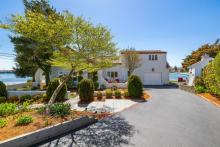Marion Selectmen approve water rate increase for current fiscal year
Marion Selectmen approved water and sewer rate increases for residents that will take effect this year.
It’s the first time the Selectmen, who also serve as the Water and Sewer Commissioners, have approved a rate hike since 2007. That year, rates rose 70 percent for customers, and in some cases it jumped higher for heavy water and sewer users.
Since then, revenues and expenditures have been scrutinized by financial and water officials annually.
“I don’t want you to think this is something we take lightly,” said Finance Director Judith Mooney. “I do have to tell you you’re not going to meet revenues if we don’t have a rate increase.”
Mooney, alongside Department of Public Works and Water Department employees, recommended the higher rates at a specially scheduled Selectmen’s meeting held Tuesday night.
As approved, base rates for water and sewer customers will increase by 2.5 percent. Water users in the second and third tier of consumption, which use more water than first tier users, will see usage fees jump an additional three percent. First tier users will not see an additional increase.
Sewer users at all three tiers will face an additional 10 percent fee on top of the base rate increase.
Mooney estimated the typical household water and sewer bill will cost $9.73 more per billing cycle. In Marion, water and sewer bills are collected quarterly.
For a family of four, Mooney said the combined increase for water and sewer use will be $26.89 more per billing cycle. She said those figures did not account for the base increase.
The rate increases are primarily due to the need for infrastructure upgrades and repairs. Officials said residents should expect another round of rate increases next year to keep up with costs and to pay for an unfunded federal mandate that could potentially cost the town millions of dollars.
Residents questioned the feasibility of putting the burden solely on ratepayers.
Compared to Mattapoisett, Jim Stewart said Marion residents pay 60 percent more on average for water and sewer. He suggested looking at regionalizing the water system with a neighboring town to cut costs.
“Rather then build another wastewater treatment plant, maybe we should use best practices,” Stewart said.
That’s not a fair comparison, said Town Administrator Paul Dawson. Each city and town is unique in how it handles wastewater. He noted that Mattapoisett currently lacks much of the infrastructure that Marion has.
“That’s comparing apples to oranges. [Mattapoisett] does not have a sewage treatment plant, it does not have water tanks,” Dawson said. “Mattapoisett will catch up with us, but until then, simply comparing the rates oversimplifies the problem.”
Jay Ryder, a former Planning Board member, disagreed.
He cited a study by the engineering firm Tighe & Bond that rated Massachusetts’ cities and towns by how much residents pay for water and sewer.
According to Ryder, Marion’s water and sewer rates were listed third and second highest in the state, respectively.
“We are starting with some of the highest sewer and rates in the commonwealth,” Ryder said.
Mooney disputed Ryder’s statement, and she said she would look into how the study came to that conclusion.
Officials said residents should expect another rate increase next year as they grapple with a mandate from the Environmental Protection Agency.
Future sewer rates are difficult to predict due to uncertainty regarding the town’s National Pollutant Discharge Elimination System permit (NPDES).
A draft permit, released in December, is required for facilities that discharge water into the environment.
It identifies and limits the amount of pollutants released, such as toxins, nitrogen and copper.
The permit, as written, is so different from the previous one that it’s impossible to follow the new regulations without significant wastewater plant upgrades – possibly costing tens of millions of dollars.
Selectmen said water and finance officials will work towards a solution this year.













